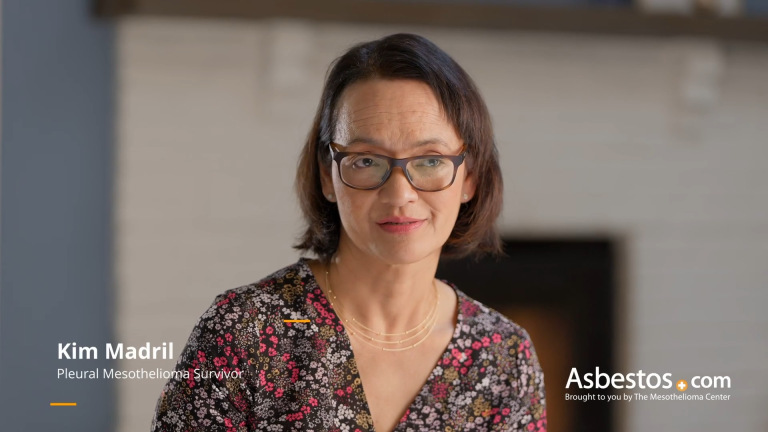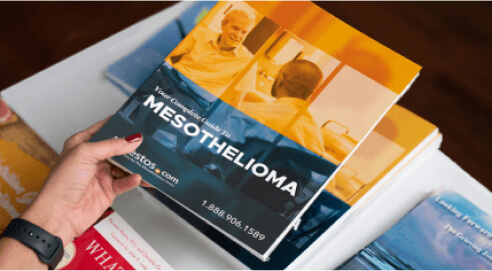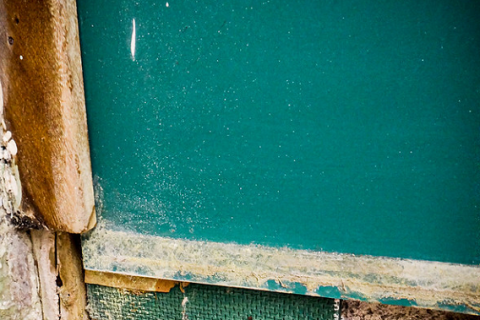
Asbestos in Schools: A Guide for Parents & Administrators
Written by Matt Mauney | Edited By Walter Pacheco
Many of America’s students, teachers and school staff are in danger of asbestos exposure because the deadly carcinogen lurks behind walls, above ceilings and under floors in older schools across the United States. Understanding the risks and how to avoid asbestos could protect their safety.

Understanding the Risks of Asbestos Exposure in Schools
When asbestos products are damaged or wear down over time, students, teachers and other school employees are at risk of asbestos exposure.
Inhaling or ingesting microscopic asbestos fibers can lead to severe health conditions, such as asbestosis, lung cancer and mesothelioma, decades after exposure. Asbestos is the primary cause of mesothelioma.
The U.S. Environmental Protection Agency estimates that asbestos-containing materials are in most of the nation’s primary, secondary and charter schools.
A 2015 investigative report commissioned by Senator Ed Markey (D-Mass.) and Former Senator Barbara Boxer (D-Calif.) showed that more than two-thirds of 5,309 local education agencies in 15 responding states had schools that contained asbestos.
Schools built before the 1980s likely contain some form of asbestos.
How Did Asbestos Get in Schools?
About half of all schools in the U.S. were built between 1950 and 1969 when asbestos was present in virtually every building material to increase durability and fire resistance.
Judy Goodson, diagnosed with peritoneal mesothelioma in 2013, told us, “When I was in the ninth grade, my junior high school was remodeled. I remember huge plastic sheets separating us from areas that contained asbestos. We passed by them every day. Nobody thought anything of it back then.”
- Ceiling tiles
- Vinyl flooring (including backing and glue)
- Wallboard
- Duct work for heating and cooling systems
- Pipe wrap insulation
- Boiler insulation
- Cement sheets
- Textured paint or “popcorn” ceilings
The general public wasn’t aware of the health dangers of asbestos exposure at the time. Products containing asbestos do not pose a threat if left intact and undisturbed.
However, most of these materials deteriorate and become damaged during negligent maintenance work or improper abatement procedures.
Exposure to asbestos goes beyond occupational exposure, old buildings, like schools, contained asbestos in many different areas. I have worked with numerous teachers over the years who unfortunately developed mesothelioma cancer. Their exposure to asbestos has been linked to asbestos products that were in the schools they taught in. There have also been patients who worked in the school’s maintenance department and were exposed to asbestos while fixing things such as furnaces.

Where Was Asbestos Used in Schools?
Until the 1980s, asbestos was present in products used in classrooms, auditoriums, teachers’ lounges, school corridors and other high-traffic areas.
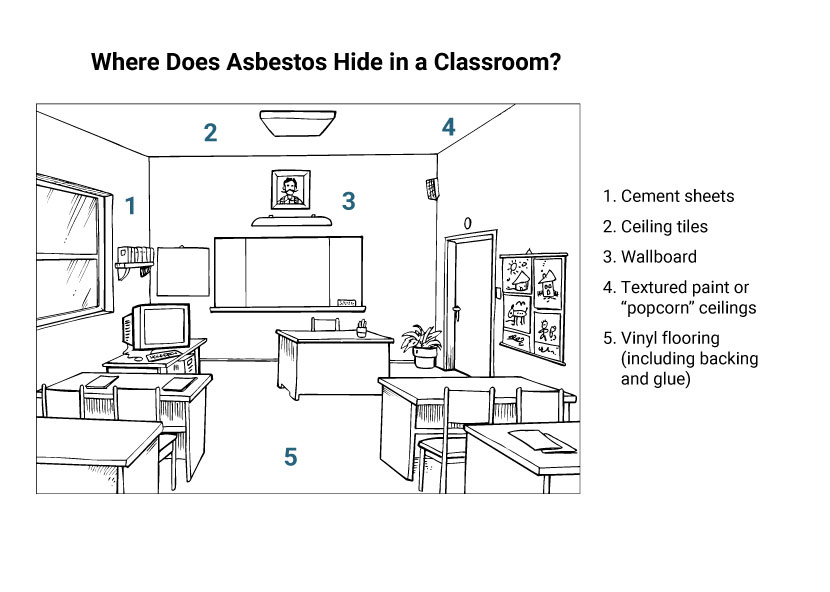
Asbestos is a naturally occurring mineral once praised for its ability to insulate and fireproof building materials.
What Was Done About It?
Congress passed the Asbestos Hazard Emergency Response Act (AHERA) in 1986 to protect students and teachers from asbestos exposure in school buildings.
The law rarely requires schools to remove asbestos materials as long as they remain in good condition. According to the EPA, asbestos-containing products that are stable and in good condition pose “relatively little risk to students and school employees.”
- Inspect their buildings for asbestos-containing materials every three years
- Prepare and maintain asbestos management plans
- Designate and train a person to oversee asbestos-related activities
- Perform appropriate response actions to prevent or reduce asbestos hazards
A poorly conducted removal of asbestos materials can increase exposure risk. Instead, AHERA encourages schools to keep asbestos-containing materials in good condition through a particular maintenance plan.
What Is the Current Status of Asbestos in Schools?
A September 2018 report from the EPA’s Office of Inspector General shows the agency isn’t doing enough to minimize asbestos risks in U.S. schools.
According to the report, the EPA conducted only 13% of the nationwide AHERA inspections it was responsible for from 2011 through 2015.
Half of the agency’s 10 regional districts only check for asbestos in a school if they receive a specific complaint.
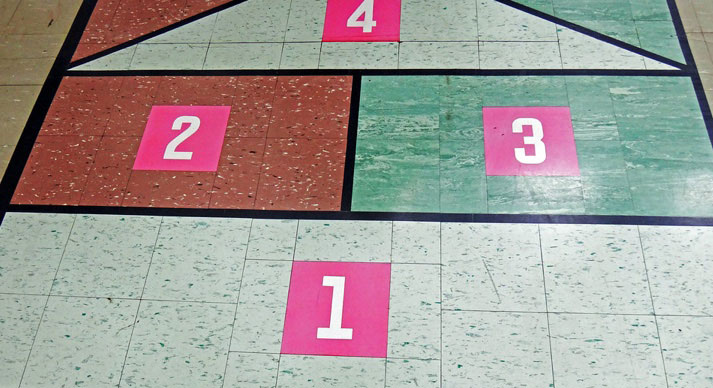
The EPA is responsible for federal inspections in 29 states, including California, Florida and Michigan. All other states either implement and oversee their asbestos-in-school regulations or conduct their inspections with EPA oversight and enforcement.
A lack of funding for regional AHERA programs and little to no oversight in most of the country increases the risk that asbestos in schools may go unnoticed, potentially leading to dangerous exposure.
Students More at Risk Than Teachers
In 2013, research from the U.K. government’s Committee on Carcinogenicity (COC) showed children are more vulnerable to asbestos exposure than adults.
The COC concluded a 5-year-old child’s lifetime risk of developing mesothelioma cancer is approximately five times greater than that of a 30-year-old adult.
I went to a school with exposed asbestos in the gym every day. I hate to think about how many other kids this will happen to in schools today. Because it’s not at the forefront, no abatements are going on.
An EPA risk assessment study from the early 1980s estimated that 1,000 premature deaths related to asbestos exposure would occur over the next 30 years, with people exposed as schoolchildren accounting for 90% of those deaths.
These findings were a driving force behind the development of mandated asbestos control programs in schools.

Talking to Your Student’s School About Asbestos
As a parent or guardian, you want to know your students are safe at school, and talking to school officials about the school’s responsibility, asbestos management plan, and financial obligations can help.
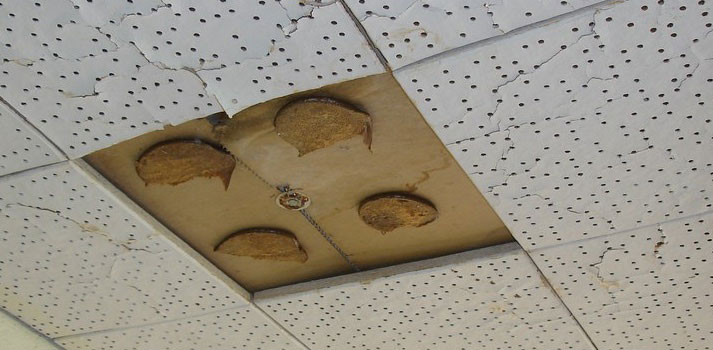
Federal regulations do not require schools to remove asbestos materials until after demolishing the building, and programs like AHERA don’t always ensure the safety of students and faculty.
For example, states in the EPA’s Region 7—Nebraska, Iowa, Missouri and Kansas—only conducted six asbestos inspections between 2012 and 2016. Some federal jurisdiction states, including Arkansas and New Mexico, performed no inspections then.
What Is the School’s Responsibility?
A school’s responsibility for dealing with asbestos depends on the state and the school district’s responsibility under AHERA. Some states fall under federal jurisdiction, while others implement and manage their asbestos management programs.
The 2018 Office of Inspector General Report showed that schools in states outside of federal jurisdiction more often inspect and appropriately manage asbestos in schools.
Concerned parents should contact school administrators to ensure the school has prepared an asbestos management plan. AHERA requires schools to share these plans with anyone who requests them within five days of the request.
School districts outside of AHERA oversight should have asbestos management plans.
You may need to reach out to officials at the school district office to obtain this report.
The asbestos management plan will tell you when the school had its last inspection, whether asbestos was present and what plans the school has to manage these materials.
Review the School’s Asbestos Management Plan
Under AHERA, the asbestos management plan should document the following:
- Contact info of a designated, trained person to oversee asbestos-related activities in the school system
- Inspection protocols, including information of an accredited asbestos inspection and abatement partner
- How the school plans to manage asbestos materials and prevent exposure
- Details of how the school will notify the public about asbestos inspections and the availability of updated management plans
- Records of all asbestos-related activities
The designated asbestos contact person should be able to answer any additional questions you may have.
Federal, Waiver and Non-Waiver States
The EPA is responsible for conducting AHERA compliance inspections for most states.
There are 12 “waiver states” that implement and oversee their asbestos school programs and nine “non-wavier states” that conduct their inspection with EPA oversight and enforcement.
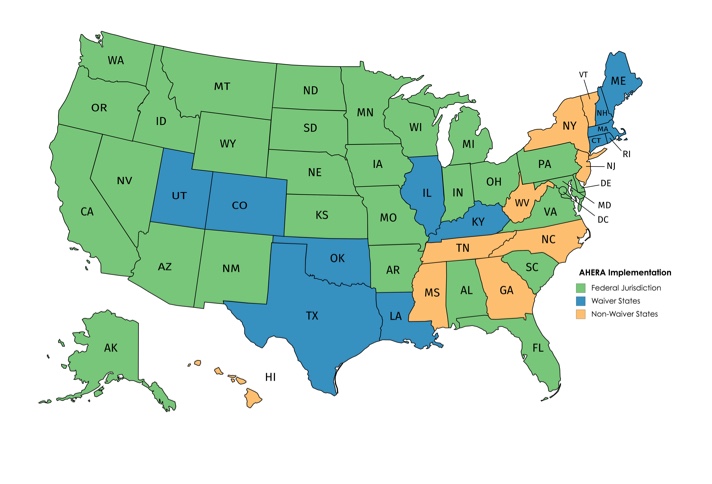
According to the 2018 report from the EPA’s Office of Inspector General, schools in waiver and non-waiver states completed 87% of the required asbestos inspections from 2011 to 2015.
States under federal jurisdiction only performed 13% of required inspections, with an average of 28 inspections in each of the 29 states. According to the Jacobs report, it would cost $2.2 billion to get all 307 public school facilities in Rhode Island into “ideal” condition.
“Our survey results indicated that regional AHERA programs are not well funded and inspection numbers in waiver and non-waiver states significantly outnumber those in federal implementation jurisdictions,” the Office of Inspector General report reads.
Understanding the Financial Obligations of the School
AHERA passed in 1986. Federal funding for the legislation dried up in the 1990s, leaving many schools and school districts to implement their asbestos action plans.
Twenty-one states complete independent inspections, and 12 run programs separate from EPA oversight and enforcement. The Office of Inspector General report shows that these states are doing better than states with federal implementation jurisdiction.
However, any inspection, management or removal of asbestos materials can be extremely costly.
For example, it would cost $2.2 billion to get all 307 public school facilities in Rhode Island into “ideal” condition — including removing unabated asbestos materials — according to the 2017 Jacobs Recommendations for Consideration, a statewide, independent assessment.
The health and safety of students and staff should be the school’s top priority. But sometimes, financial restraints tie the hands of cash-strapped communities.
Fundraising for key asbestos management or abatement projects can help school districts reach their goals. Call your local superintendent to find out how you can help.

What Happens When Asbestos Is Found in Schools?
AHERA outlines proper methods for dealing with asbestos in schools. States that don’t fall under EPA oversight and enforcement may handle these measures differently.
In general, asbestos action plans will include one or more of the following:
- Maintenance
If the identified asbestos materials are in good condition, schools will follow a special maintenance plan to ensure they remain that way. Maintenance efforts should be outlined in a school’s asbestos management plan.
- Repair
Maintenance staff may repair damaged pipe or boiler coverings that contain asbestos insulation. These jobs are usually small in nature and involve limited amounts of asbestos
- Encapsulation
This involves spraying exposed asbestos materials with a thick, paint-like sealant to prevent fiber release.
- Enclosure
Similar to encapsulation, enclosure involves building an airtight barrier around asbestos. This can be built of wood, metal or sheetrock.
- Removal
Removing asbestos is the only permanent solution for controlling and preventing future exposure. Asbestos-containing materials are removed and replaced with non-asbestos products.
Encapsulation, enclosure and removal must be done by an accredited asbestos professional. Some repair jobs may require a licensed professional as well.
Asbestos removal from schools is usually a last resort because of high costs and the potential for increased exposure.
Examples of Asbestos Issues in U.S. Schools
-
 ChicagoA 2016 EWG Action Fund study showed that students and teachers in nearly 200 Chicago public schools were at risk of asbestos exposure. Only 11 of 184 elementary, middle and high schools identified in an asbestos surveillance update complied with recommendations.
ChicagoA 2016 EWG Action Fund study showed that students and teachers in nearly 200 Chicago public schools were at risk of asbestos exposure. Only 11 of 184 elementary, middle and high schools identified in an asbestos surveillance update complied with recommendations. -
 PhiladelphiaThe School District of Philadelphia spent the summer of 2018 inspecting and cleaning up seven elementary schools found to have alarming levels of asbestos fibers. An investigation by the Philadelphia Inquirer found 10.7 million asbestos fibers in one sixth-grade classroom after a building engineer stripped insulation from a steam pipe, leaving debris on the floor.
PhiladelphiaThe School District of Philadelphia spent the summer of 2018 inspecting and cleaning up seven elementary schools found to have alarming levels of asbestos fibers. An investigation by the Philadelphia Inquirer found 10.7 million asbestos fibers in one sixth-grade classroom after a building engineer stripped insulation from a steam pipe, leaving debris on the floor. -
 Hartford, ConnecticutOfficials closed the Wish School in Hartford for two days in 2017 after contractors exposed asbestos insulation when removing old lockers from the school.
Hartford, ConnecticutOfficials closed the Wish School in Hartford for two days in 2017 after contractors exposed asbestos insulation when removing old lockers from the school. -
 Manhattan Beach, CaliforniaThe Manhattan Beach Unified School District was cited with 27 violations in August 2018 for negligent renovations at Mira Costa High School in Los Angeles County. Contractors at the school allegedly disturbed asbestos tiles in the library while students and parents were registering for the school year.
Manhattan Beach, CaliforniaThe Manhattan Beach Unified School District was cited with 27 violations in August 2018 for negligent renovations at Mira Costa High School in Los Angeles County. Contractors at the school allegedly disturbed asbestos tiles in the library while students and parents were registering for the school year.
Resources for Parents
The EPA website is a good resource for additional information about asbestos in schools and federal requirements.
Helpful Links:
- Asbestos in Schools Fact Sheet
- Healthy Indoor Air Quality in Schools
- AHERA Asbestos Management Plan Checklist
- Asbestos Management Plan Template
Additional Asbestos in Schools Resources
- Asbestos Removal Costs (HomeAdvisor.com)
- Directory of Public School Districts (National Center for Education Statistics)
- State Contacts and Information (U.S. Department of Education)
- Asbestos Abatement Guide (The Mesothelioma Center at Asbestos.com)

Asbestos in Colleges and Universities
While AHERA regulations address asbestos issues in elementary and secondary schools, the EPA, the Occupational Safety and Health Administration and various state and municipal laws regulate asbestos removal procedures for the nation’s colleges and universities.
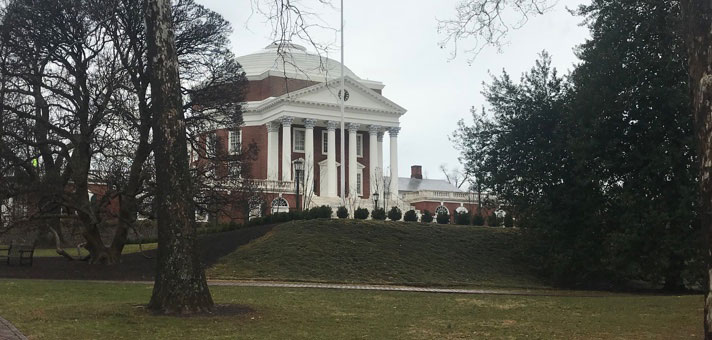
According to the National Center for Education Statistics, there are roughly 4,300 degree-granting postsecondary institutions in the U.S. as of the 2017-2018 school year:
- 1,626 public colleges
- 1,687 private nonprofit schools
- 985 for-profit schools
OSHA requires universities and colleges to adhere to asbestos regulations to keep students and staff safe. These include building surveys, asbestos warnings and more.
OSHA requires all colleges to:
- Survey their buildings and test for asbestos.
- Maintain records of any samples taken during maintenance, construction or demolition activities.
- Provide notifications regarding the locations of asbestos in their buildings.
- Post appropriate warning signs when asbestos-containing materials are identified or suspected.
- Provide asbestos training to maintenance and custodial employees.
Failure to follow OSHA and EPA guidelines during asbestos work or maintenance that may disturb asbestos materials can result in significant fines levied on any non-complying institution.
Examples of Asbestos in U.S. Colleges
-
 State University of New York at GeneseoA 2019 report revealed that Blake Hall — built in 1949 — was contaminated with asbestos. “There’s asbestos in almost every building we have,” Assistant Vice President for Facilities & Planning George Stooks told The Lamron, SUNY Geneseo’s student newspaper. “The older the building, the more prevalent it is.”
State University of New York at GeneseoA 2019 report revealed that Blake Hall — built in 1949 — was contaminated with asbestos. “There’s asbestos in almost every building we have,” Assistant Vice President for Facilities & Planning George Stooks told The Lamron, SUNY Geneseo’s student newspaper. “The older the building, the more prevalent it is.” -
 University of VirginiaUniversity Hall, the former home of the University of Virginia’s men’s and women’s basketball programs, was imploded May 25, 2019. Renascent, the demolition company handling the project, previously completed an asbestos abatement at the facility, which opened in 1965.
University of VirginiaUniversity Hall, the former home of the University of Virginia’s men’s and women’s basketball programs, was imploded May 25, 2019. Renascent, the demolition company handling the project, previously completed an asbestos abatement at the facility, which opened in 1965. -
 University of MontanaIn January 2019, students and faculty of a preschool in McGill Hall on the campus of the University of Montana were relocated to a new classroom after “unacceptable levels” of asbestos were discovered. “Forever, we’ll have this anxiety that our kids are going to get cancer,” one parent told the Missoulian.
University of MontanaIn January 2019, students and faculty of a preschool in McGill Hall on the campus of the University of Montana were relocated to a new classroom after “unacceptable levels” of asbestos were discovered. “Forever, we’ll have this anxiety that our kids are going to get cancer,” one parent told the Missoulian.
Latest Asbestos Lawsuits Over Exposure at Schools and Universities
Asbestos lawsuits against schools aim to hold them liable for exposure. Defendants can be liable for negligence that leads to exposure.
Teachers, students and alumni, custodians and faculty have all filed claims. Families have also filed wrongful death lawsuits.
- October 2024: Donna Spurling is suing Fairmont State University. Doctors diagnosed her with mesothelioma. Spurling attended the West Virginia school from 1998 to 2004. Her suit claims the university exposed her to asbestos. It says the board of governors covered up the school’s asbestos problem.
- March 2024: Juan Namnun is suing the School District of Philadelphia. He taught physical education at Frankford High School for decades. Namnun was diagnosed with a rare breast cancer in 2022. It’s called papillary carcinoma. He underwent a double mastectomy. He also had reconstructive surgery and chemo. His suit blames asbestos exposure for his illness.
- February 2020: A teacher in Philadelphia, Lea DiRusso, sued the Board of Education. She received a settlement of $850,000. In 2019, doctors diagnosed DiRusso with mesothelioma. She had taught at 2 schools, both contaminated with asbestos, for nearly 30 years. After the settlement, the school board warned teachers about asbestos in schools.
Plaintiffs will need to document their diagnoses. Asbestos lawyers then build the case. They show the link between the diagnosis and asbestos at the school. Successful cases result in compensation. This can help cover medical expenses or lost wages.

Asbestos in Schools FAQs
- How do I find out if my child’s school has asbestos in it?
-
Call your school administrator and request a copy of the school’s asbestos management plan. This report should detail when the last asbestos inspection occurred and if exposed asbestos materials were found. The plan will also designate an asbestos contact person and provide contact information. You may need to reach out to your school district’s main office for this plan.
- How do I find out if the school was required to be inspected for asbestos?
-
First, you should find out when the school was built. If it was constructed before the 1980s, there’s high probability that some form of asbestos is within the walls, ceilings or floors of the facility.
Next, find out if your state falls under federal jurisdiction for inspections, or if it is a waiver or non-waiver state. Implementation of AHERA falls to the EPA regional offices. You can contact your school or school district directly to see if inspections are required.
- Is it dangerous to have asbestos-containing materials in my school?
-
Not necessarily. Asbestos is only dangerous when the mineral’s tiny fibers are disturbed and released into the air. According to the EPA, as long as asbestos materials are in good condition and properly maintained, they pose “relatively little risk to students and school employees.”
However, inspections should identify and evaluate these materials to prevent disturbing the products during renovations or demolitions.
- My child’s school has asbestos in it. Why aren’t they taking it out?
-
Sometimes, it can be more dangerous to remove asbestos from a building than manage it. According to AHERA guidelines, asbestos removal is necessary only when the material damage is “extensive and severe, and other actions will not control fiber release.” Schools typically respond to asbestos by either repairing, encapsulating or enclosing materials.

